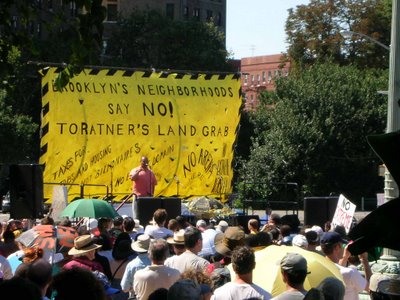Democratic Space

Finally, something to write about: the Draft Environmental No-Impact Statement was released this week. Although I’m still making my way through the Table of Contents (it’s 34 pages!), I skipped ahead a bit and got an overall impression of how, as the saying goes, figures can lie, and liars can figure.
The document now recognizes that a Floor Area Ratio without streets is a different measure of density than a Floor Area Ratio with streets. But not so for the Open Space Ratio. So, you may be surprised to read, as I was initially, that after building over 8 million square feet of concrete, steel and glass, plus parking for 3800 cars, the open space ratio for “passive” open space throughout the neighborhood actually improves! Incredible! How could this be? It’s because when an area is used as a public street, it is not counted as open space, despite Ms. Burden’s contention. But when the street is given to a private project to be used for “strolling, dog walking, and bird watching” it IS counted as open space.
One would think that a qualitative assessment of potential open space impacts would address how removing street right-of-ways impacts effective open space ratios. One reason that the city has a planning goal of 2.5 acres per 1,000 residents for large projects, while the median existing local area open space ratios is 1.5 acres per 1,000 residents, is that large projects provide an opportunity to correct problems, rather than exacerbate them. Another reason why the goal for large projects should be higher than the existing median is that in large areas without streets there is more of a need for views of the sky, light, and landscape, features which are typically provided by streets. Imagine an area with no streets. Would a given open space ratio there provide the same benefits as an equivalent open space ratio in an area with streets? Of course not.
Throughout the document, private “open space” is referred to as “publicly accessible open space” (not to be confused with real open space, which is public and doesn’t require authorization for access). But now we learn that “publicly accessible open space” is not public open space at all, and would only be “available for public use” during limited hours. After all, “security” for the open space, the document states, would be provided by the project sponsors. So if you thought that this was your borough, think again. If you give away this amount of property, including the streets, you give away that essential quality of cities: democratic participation in public space. Sure, a developer can be benevolent, but he doesn’t need to be. But let’s not misplace our anger: the developer is trying to make a buck, it’s our elected officials who are facilitating this defeat of our public realm. And we voted for them!

5 Comments:
Finally!
Is the EIS accessible to all and where can I locate it?
As a person who uses Prospect and Central Parks a lot for athletic training, I've noticed many, many more people in the parks, year after year. And with all the new development, that's just going to get worses. The parks aren't getting any bigger. And none of the "public space" in any of these developments is space that can be used for running or cycling.
Doesn't anyone think about this stuff???
it's probably online somewhere, but i think the public libraries have it as well.
http://www.empire.state.ny.us/AtlanticYards/
here is the link if others are interested...
It is interesting that all of the development is based on the car model - for example the use of eminent domain on Duffield - will destroy two pre-civil war houses to building a parking lot - the more parking lots you build, instead of investing in mass transit you encourage more, not less traffic . All of the strip mall style developments that have been put in around Atlantic yards (the pc richards for example) encourage this suburban sprawl style of urban planning, or lack there of.
Not only are these cronies of Ratner at ESD corrupt but they are thinking along 1970s models.
In addition it's interesting that Markowtiz can only think about increasing tax revenue (and thus more government power) and not the long term effects to Brooklyn.
Post a Comment
<< Home